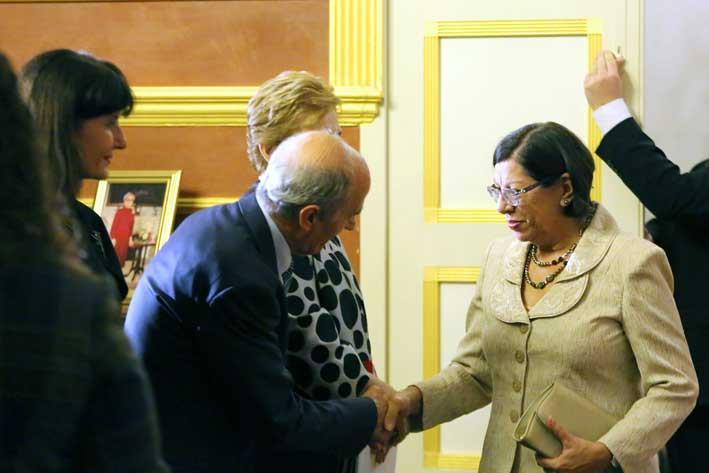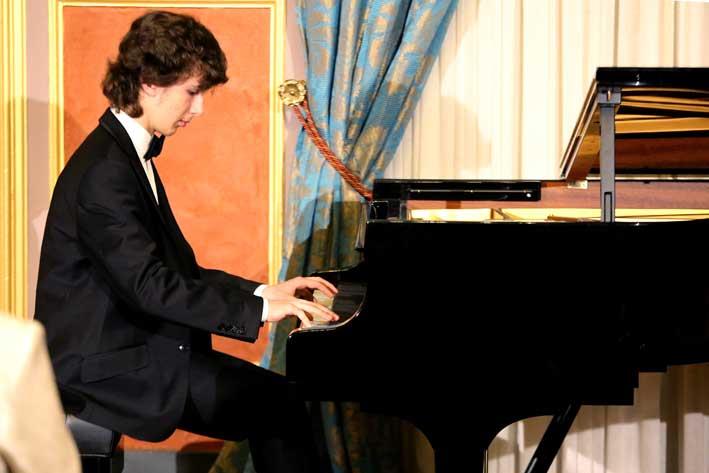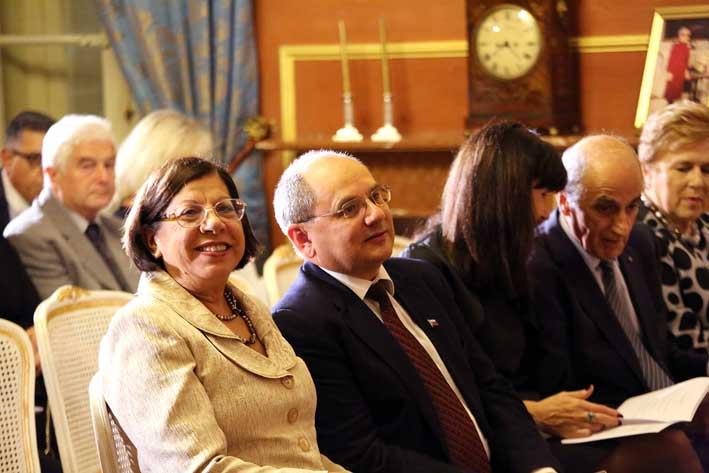There is little doubt that Martin Chudada, the young Slovakian pianist, born in 2001, was in the front row when God was giving out his musical gifts. He had been engaged to play for the celebration of Slovakia's national day which I knew I was going to have to miss this year so was very pleasantly surprised to receive an invitation to hear him play at San Anton Palace.
The programme indicated he is merely 17 years-old. By the age of ten he was already playing a Bach concert in public. From early childhood he was a prize winner and remains so to this day. Martin may not read the philosopher Heiddiger with his morning coffee but he has won significant awards for mathematics too.

That evening he had already scored a triumph by the time he came to the end of his first piece, Schumann's Variations on the name "Abegg" which he played with refreshing ardour. This young man plays with poetic feeling and without a hint of heaviness. Cool, as today's generation would have it. Yes, very cool.
Robert Schumann was yet another composer whose life was a tale of tragedy and early death. He was a brilliant composer, but spent most of his life in the shadow of his wife, Clara Schumann, who was one of the famed pianists of the day. She was less well known as a composer.
Schumann was unable to follow his dream of becoming a concert pianist because of an injury to his hand, and he was not always happy to live in the shadow of his wife's celebrity.
He is best remembered today for his piano pieces, his songs and his chamber music. Schumann suffered from syphilis and depression, trying to commit suicide by throwing himself into the River Rhine. He was placed in an asylum, where he died two years later. But most people remember his music rather than Clara's and that surely should cheer him up wherever he is.

The next piece on the programme was Mozart's Turkish March perhaps better known as Rondo a la Turca. Those of us who, in our youth were encouraged by our parents to take piano lessons and try to bridge the gap between us and famed composers like Mozart, know it well and dreamt of playing it properly. It is one of Mozart's best-known tunes and is actually the third and final movement from his Sonata No. 11 in A Major K331 for piano.
How sad that someone as gifted as Mozart, a child prodigy should die at the age of 37.
Perhaps Turkey should have adopted this lively piece of music as its national anthelm.
Sir Thomas Beecham said about Wolfgang Amadeus: "If I were a dictator, I should make is compulsory for every member of the population between the ages of four and eighty to listen to Mozart for at least a quarter of an hour daily for the coming five years."
********************
Our young pianist, calm, cool and collected went on to give us Claude Debussy's Estampes. Sensitive and personal Martin is without preening mannerisms.
And so to Stravinsky's selection from his famous ballet Petrushka. Here's a little diversion. It is rumoured that Coco Chanel and Igor Stravinsky had an affair. I know that she created costumes for the Ballet Russes but not for Petrushka. In 2009 a film Coco Chanel & Igor Stravinsky was chosen as the Closing Film of the 2009 Cannes Film Festival.
According to Justine Picardie's book on Coco Chanel, CC had provided a home for Stravinsky (whose wife was ailing), and his family at her villa Bel Respiro at Garches. At the time the composer was utterly impoverished.
Seven years later she was to say of him: "He was still not very cosmopolitan, and he was very Russian in his ways, with the look of a clerk in a Chekhov short story. A small moustache beneath a large rat-like nose. He was young and shy; he found me attractive."
This was not the first time that Coco Chanel had come to the rescue of Stravinsky. Through Diaghilev she had made a financial donation to the Ballet Russes to support the revival of the ballet Le Sacre du printemps - The Rite of Spring. Further more the costumes of the ballet were made in her atelier.

By now the audience was in love with this young pianist. His last piece was Prokofiev's March from The Love for Three Oranges. Serge Prokofiex was another whizz-kid and a giant of20th century Russian music. He had managed to clock up two whole operas by the time he was 11.
Like Stravinsky, he too was commissioned by Diaghilev to write two ballet scores, but neither enjoyed the great success of Stravinsky's big hits.
Prokofiev decided to move to the USA after Lenin took control in Russia, and he achieved major success as a concert pianist. He was commissioned to turn his piano work The Love of Three Oranges into an opera. It had a rocky beginning but has eventually become one of his best-loved pieces - and certainly his most successful opera. In my view this March is a fun piece and Martin Chudada was having fun playing it, although, on the whole, he looks like an enigmatic and serious young man.
The Acting President, Mrs Dolores Cristina, while thanking the pianist at the end of the concert remarked that she couldn't understand how he fits all these interests in a 24-hour day. Indeed.
And after such a brilliant concert I couldn't help wondering why classical musicians unlike teeny bop musicians, don't have posters and tee-shirts with their name and photo plastered all over and which could add quite a bit to their nest-egg. That's not the way the world works. But even without tee-shirts Martin Chudada is bound to go a long way. In fact he has already come a long way. I was probably still with a skipping rope in my hands at that age, struggling with Mozart's Rondo a la Turca.
[email protected]